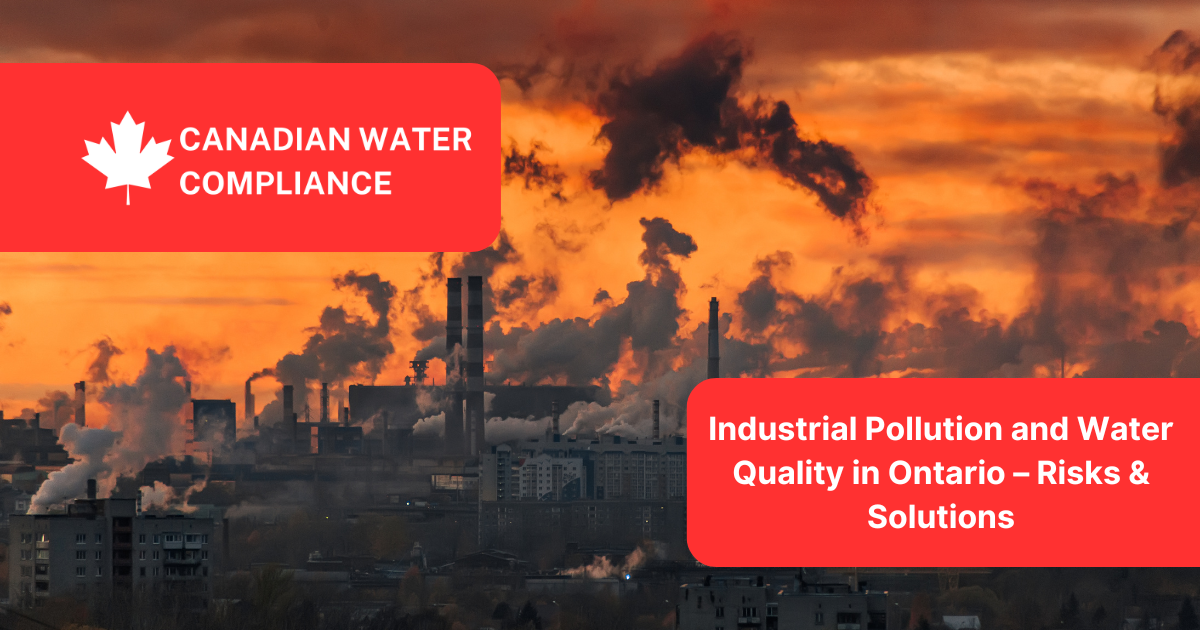
Written By: Canadian Water Compliance | On
Water is one of Ontario’s most valuable resources, providing drinking water for millions of residents and supporting diverse ecosystems. However, industrial pollution remains a significant challenge, affecting water quality in rivers, lakes, and groundwater sources. Contaminants from factories, wastewater discharge, and industrial runoff can introduce harmful substances into the water supply, posing risks to both human health and the environment.
Industrial activities release various pollutants into water bodies, including heavy metals, chemicals, and organic waste. These contaminants can originate from manufacturing plants, mining operations, and processing facilities. The primary ways industrial pollution affects water quality include:
🔹 Heavy Metal Contamination – Industries such as mining, metal processing, and manufacturing release heavy metals like lead, mercury, and arsenic into water bodies. These toxic substances can accumulate in aquatic life and pose serious health risks to humans.
🔹 Chemical Runoff – Chemicals from industrial sites, including pesticides, solvents, and petroleum byproducts, can seep into rivers and groundwater, impacting drinking water sources and aquatic habitats.
🔹 Thermal Pollution – Power plants and factories often discharge heated water into lakes and rivers, altering natural temperatures and affecting fish populations and aquatic ecosystems.
🔹 Nutrient Overload – Industrial agriculture contributes to excess nitrogen and phosphorus entering waterways, leading to harmful algal blooms, oxygen depletion, and fish kills.
Ontario has witnessed several high-profile cases of industrial pollution affecting water quality:
✔ Grassy Narrows Mercury Contamination – In the 1960s and 1970s, a paper mill in Dryden, Ontario, dumped mercury into the English-Wabigoon River system, causing widespread health issues and devastating Indigenous communities. The effects are still felt today.
✔ Hamilton Harbour Industrial Discharges – Decades of industrial activity in Hamilton have led to high levels of pollutants, including heavy metals and organic contaminants, prompting extensive remediation efforts.
✔ Sarnia’s “Chemical Valley” – Home to numerous petrochemical plants, Sarnia has struggled with air and water pollution. Studies have found increased levels of benzene and other toxins in local waterways.
To combat water contamination, Ontario enforces several regulations under the Ontario Water Resources Act (OWRA) and the Environmental Protection Act (EPA). Key measures include:
✔ Effluent Limits & Water Discharge Permits – Industries must comply with strict wastewater treatment and discharge limits before releasing effluents into the environment. ✔ Source Water Protection Plans – Municipalities implement protection strategies under the Clean Water Act (2006) to prevent industrial contamination of drinking water sources. ✔ Polluter Pay Principle – Companies responsible for contamination must fund cleanup efforts and remediation. ✔ Monitoring & Enforcement – The Ontario Ministry of the Environment, Conservation, and Parks (MECP) conducts inspections and penalizes industries violating water quality standards.
Addressing industrial pollution requires a multi-faceted approach:
✔ Stricter Compliance & Enforcement – Strengthening regulations and penalties for non-compliance can deter polluters. ✔ Innovative Waste Treatment – Encouraging industries to adopt advanced wastewater treatment technologies can minimize pollution. ✔ Community & Stakeholder Involvement – Public awareness and collaboration between businesses, environmental groups, and local governments can drive sustainable industrial practices. ✔ Corporate Responsibility & Sustainability – Companies should implement green technologies, reduce waste production, and commit to environmentally friendly practices.
Industrial pollution remains a major threat to Ontario’s water quality, but regulatory efforts and environmental advocacy continue to push for cleaner waterways. Businesses, policymakers, and residents all have a role to play in ensuring safe and sustainable water resources for future generations.
📞 Need expert water testing in Ontario?
Contact Canadian Water Compliance today for professional water quality assessments and solutions.